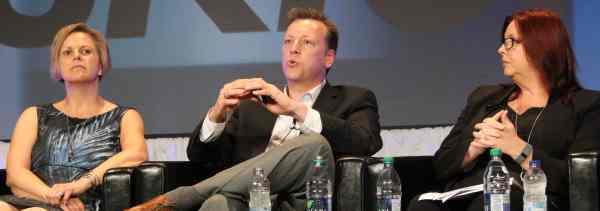
TORONTO – There’s no shortage of speeches, books, news articles, research papers and executive presentations on the value of improving customer experience to the bottom line.
But the message still hasn't sunk through to some executives, a customer experience panel at the annual Canadian Telecom Summit in Toronto heard on Monday.
”Customer experience is still one of those things people pay lip service to,” said Aaron Nielsen (pictured, centre with Stacey Sandison at left and Arleen King at right), president of ThinkCX Technologies, a Vancouver company whose analytics platform helps predict customer behaviour. “There's not a carrier in North America that wouldn't say they're not differentiating themselves on customer experience, but when it comes down to it and you look at the numbers… they're not embracing it the way they need to, to transform their business. The case still needs to be made to certain companies. Exceptions more than the rule are making the transformation,” he said. “More and companies are going to have to make that transition to be successful.”
He wasn't the only skeptical panel member. “Our work is never done,” said Arleen King, senior vice-president of customer service at Telus. “If you want to differentiate yourself on service it's still worth pursuing because there's still a lot of white space in the customer experience field. I don’t think any of us can say we’ve done enough yet.”
Everyone on the panel – which also included Emiliano Conde, president of jBilling, an Ottawa-based billing specialist which has several large international telcos as customers; Tal Schierau, vice-president and general manager of customer success at Radialpoint, a Montreal-based customer service supplier to a number of Canadian carriers; and Stacey Sandison, chief strategy officer at SaskTel – agreed on the importance of superior customer service. But they also agreed there’s a long row to hoe.
The lively session was moderated by telecommunications complaints commissioner Howard Maker, who pointed out that the biggest complaints he fields from customers are about bills. “You wouldn’t believe some of the bills we see,” he said. Why, he asked, is it so hard to get it right?
There's a disconnect between what people think they are buying and what they company thinks it is selling, said Conde. For example, a wireless customer may think he is buying two services – voice and data. The carrier sees it selling half dozen services, which are listed on the bill.
“I think there’s a lot that can be done on invoice presentation,” he said. “It's not hard to do but takes a lot of thinking.”
“I think there is lot of low hanging fruit to improve customer experience.” Customers see bills as the main touchpoint with a provider, but it has to be accurate. “You’d be surprised how many times it is not,” Conde added.
“You can increase brand loyalty… and revenue” with better bills, which, he added “could be a source of new business, a way to marketing, rather than just a way to communicate that someone one has pay.”
Listening to customers – a constant refrain from panelists – is essential, added King, who noted that after repeated complaints, Telus dropped its cellphone activation charge, which every other carrier had also added to new subscribers. “Sometimes,” she said, “you get too fancy.”
“If you just focus on cost offload you never get the true goodness of what you can get.” – Arleen King, Telus
There were success stories, too. Sandison outlined a $650 million SaskTel project that she said had the potential to destroy its relationship with customers: digging up property around tens of thousands of homes in Saskatchewan to upgrade copper telecom lines to fibre optic so the carrier could offer next-generation high speed connectivity. The goal was not only to minimize disruption if possible, but also to not lose customers.
That it didn't go south is testament to SaskTel's determination and planning, she said. That included setting clear goals, defining senior leadership roles, setting up cross-functional teams, having a multi-layered communications plan to keep customers informed about construction in their area, marketing campaigns and “regularly and vigorously” measuring performance across objectives.
The results saw 19% of its base buy a package with an increase in speed and an average increase in customer revenue of 6%.
Telus, King said, decided several years ago to make customer satisfaction a key differentiator against competitors by changing the carrier's culture. That meant making everyone in the company accountable for improving the experience of customers they dealt with. In addition, barriers that prevented staff from “doing the right thing,” were eliminated, giving support staff more flexibility to use their own judgement.
As a result, 95% of customers recommend Telus to others, said King. “When we started out that certainly wasn’t the case”, she said. As a result, customers spend less time and effort with support staff. “If you just focus on cost offload you never get the true goodness of what you can get… by focusing on the customer – and by reducing their effort you end up reducing your own cost.”
There was also plenty of advice to customer service executives. Hire the right people who can deliver good customer experience and can learn, have a good knowledge base, and put the right tools – automated or support processes — in agents' hands, said Schierau.
Learn the language of the C-suite to convince them of the value of improving customer experience, said Nielsen. “One of the things I recommend to anyone in customer experience is maybe put down the call centre book for a while and pick up a strategic study book, because really you need to become a salesperson to convince that C-level executive there's going to be an impact on them as a result of making these changes.”
Photo by Howard Solomon



